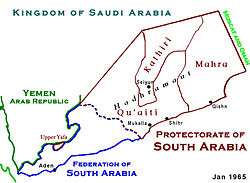Federation of South Arabia
| Federation of South Arabia | ||||||||||||||
| اتحاد الجنوب العربي | ||||||||||||||
| British Protectorate | ||||||||||||||
| ||||||||||||||
| ||||||||||||||
 Location of the Federation of South Arabia on the Arabian Peninsula. | ||||||||||||||
| Capital | Aden | |||||||||||||
| Languages | Arabic English South Arabian | |||||||||||||
| Political structure | British Protectorate | |||||||||||||
| Historical era | Cold War | |||||||||||||
| • | Established | April 4, 1962 | ||||||||||||
| • | Independence | November 30, 1967 | ||||||||||||
| ||||||||||||||


The Federation of South Arabia (Arabic: اتحاد الجنوب العربي Ittiḥād al-Janūb al-‘Arabī) was an organization of states under British protection in what would become South Yemen. It was formed on 4 April 1962 from the 15 protected states of the Federation of Arab Emirates of the South. On 18 January 1963 it was merged with the Crown colony of Aden.[1] In June 1964, the Upper Aulaqi Sultanate was added for a total of 17 states. A team was sent to the 1966 Commonwealth Games in Kingston, Jamaica. The Federation was abolished when it gained independence along with the Protectorate of South Arabia as the People's Republic of South Yemen on 30 November 1967.
States
- Aden
- Alawi
- Aqrabi
- Audhali
- Beihan
- Dathina
- Dhala
- Fadhli
- Haushabi
- Lahej
- Lower Aulaqi
- Lower Yafa
- Maflahi
- Shaib
- Upper Aulaqi Sheikhdom
- Upper Aulaqi Sultanate
- Wahidi Balhaf
Leaders
High Commissioners
- Sir Charles Hepburn Johnston (18 January 1963 – 17 July 1963)
- Sir Gerald Kennedy Nicholas Trevaskis (17 July 1963 – 21 December 1964)
- Sir Richard Gordon Turnbull (21 December 1964 – 22 May 1967)
- Sir Humphrey Trevelyan (22 May 1967 – 30 November 1967)
Chief Ministers
- Hassan Ali Bayumi (18 January 1963 – 24 June 1963)
- Zayn Abdu Baharun (9 July 1963 – 23 January 1965)
- Abdul-Qawi Hassan Makkawi (7 March 1965 – 25 September 1965)
- Ali Musa al-Babakr (25 September 1965 – 30 August 1966)
- Salih al-Awadli (30 August 1966 – 30 November 1967)
Postage stamps

The Federation issued its own Adeni postage stamps from 1963 to 1966. Most of its issues were part of the omnibus issues common to all the Commonwealth territories, but it did issue its own definitive stamps on 1 April 1965. The set of 14 included 10 values, from 5 to 75 fils, each depicting the arms of the Federation in a single colour, while the top four values (100 fils, 250 fils, 500 fils, and 1 dinar), featured the flag of the Federation.
The stamps referred to above are those listed in the Scott Standard Postage Stamp Catalog. A number of other stamps have also been issued and are listed in Stanley Gibbons and other widely used stamp catalogues. It is possible, or even likely, that some of the stamps of South Arabia were not issued primarily for postal use.
See also
References
- ↑ After Aden joined the federation, the federation was occasionally referred to as the "Colony of Aden".
Further reading
- Paul Dresch. A History of Modern Yemen. Cambridge, UK: Cambridge University Press, 2000.
- R.J. Gavin. Aden Under British Rule: 1839-1967. London: C. Hurst & Company, 1975.
- Tom Little. South Arabia: Arena of Conflict. London: Pall Mall Press, 1968.
External links
| Wikimedia Commons has media related to Federation of South Arabia. |
Coordinates: 59°59′N 179°59′W / 59.983°N 179.983°W

